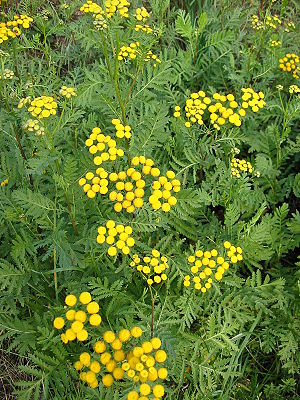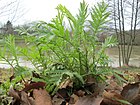Note: This is a project under development. The articles on this wiki are just being initiated and broadly incomplete. You can Help creating new pages.
Difference between revisions of "Tanacetum vulgare - Tansy"
m (Prabhakar moved page Tansy (Tanacetum vulgare) to Tanacetum vulgare - Tansy) |
|||
| Line 1: | Line 1: | ||
[[File:Tanacetum vulgare 20041012 2570.jpg|thumb|right|''Bitter buttons'', ''Tansy'']] | [[File:Tanacetum vulgare 20041012 2570.jpg|thumb|right|''Bitter buttons'', ''Tansy'']] | ||
| − | '''Bitter buttons''' | + | '''Bitter buttons''' is a perennial, herbaceous flowering plant of the aster family, native to temperate Europe and Asia. It has been introduced to other parts of the world including North America, and in some areas has become invasive. |
| + | |||
| + | ==Uses== | ||
| + | {{Uses|Intestinal ulcers}}, {{Uses|gas problems}}, {{Uses|bloating}}, {{Uses|stomachache}}, {{Uses|Skin eruptions}}, {{Uses|poor appetite}}, {{Uses|migraines}}, {{Uses|nerve pain}}, {{Uses|joint pain}}, {{Uses|epileptic seizures}}, {{Uses|fever}}. | ||
| + | |||
| + | ==Parts Used== | ||
| + | {{Parts Used|Flowers}}, {{Parts Used|Leaves}}. | ||
| + | |||
| + | ==Chemical Composition== | ||
| + | The applicable parts of tansy are the above ground parts. Tansy contains beta-sitosterol as the major sterol and alpha-amyrin as the major triterpene. Tansy also contains sterols stigmasterol, campesterol and cholesterol, and the triterpenes beta-amyrin and taraxasterol. The successful therapeutic application of this herb may be due partly to the presence of one or more of these compounds; however, results are inconclusive<ref name="chemical composition"/> | ||
| + | |||
| + | ==Common names== | ||
| + | {{Common names|kn=|ml=|sa=|ta=|te=|hi=|en=Agrimony}} | ||
| + | |||
| + | ==Properties== | ||
| + | Reference: Dravya - Substance, Rasa - Taste, Guna - Qualities, Veerya - Potency, Vipaka - Post-digesion effect, Karma - Pharmacological activity, Prabhava - Therepeutics. | ||
| + | ===Dravya=== | ||
| + | |||
| + | ===Rasa=== | ||
| + | Tikta (Bitter), Kashaya (Astringent) | ||
| + | ===Guna=== | ||
| + | Laghu (Light), Ruksha (Dry), Tikshna (Sharp) | ||
| + | ===Veerya=== | ||
| + | Ushna (Hot) | ||
| + | ===Vipaka=== | ||
| + | Katu (Pungent) | ||
| + | ===Karma=== | ||
| + | Kapha, Vata | ||
| + | ===Prabhava=== | ||
| + | |||
| + | ==Habit== | ||
| + | {{Habit|Herb}} | ||
| + | |||
| + | ==Identification== | ||
| + | ===Leaf=== | ||
| + | {{Leaf|Simple||The leaves are divided into 3-6 toothed leaflets, with smaller leaflets in between}}<ref name="Leaf"/> | ||
| + | |||
| + | ===Flower=== | ||
| + | {{Flower|Unisexual|2-4cm long|Yellow|5-20|Flowers Season is June - August}} | ||
| + | |||
| + | ===Fruit=== | ||
| + | {{Fruit||7–10 mm (0.28–0.4 in.) long pome|clearly grooved lengthwise, Lowest hooked hairs aligned towards crown|With hooked hairs|}} | ||
| + | |||
| + | ===Other features=== | ||
| + | |||
| + | ==List of Ayurvedic medicine in which the herb is used== | ||
| + | * [[Vishatinduka Taila]] as ''root juice extract'' | ||
| + | |||
| + | ==Where to get the saplings== | ||
| + | ==Mode of Propagation== | ||
| + | {{Propagation|Seeds}}, {{Propagation|Cuttings}}. | ||
| + | |||
| + | ==How to plant/cultivate== | ||
| + | Landscape Uses:Container. Succeeds in an ordinary garden soil[1]. Plants thrive in almost any soil[4]. Tansy is occasionally grown in the herb garden, though a site for growing this plant should be selected with care since it usually spreads very aggressively at the roots[<ref name="How to plant/cultivate"/> | ||
| + | |||
| + | ==Commonly seen growing in areas== | ||
| + | {{Commonly seen|waste ground}}, {{Commonly seen|hedgerows}}. | ||
| + | |||
| + | ==Photo Gallery== | ||
| + | <gallery class="left" caption="" widths="140px" heights="140px"> | ||
| + | 20180121Tanacetum vulgare2.jpg | ||
| − | |||
| − | + | 20160618Tanacetum vulgare1.jpg | |
| + | |||
| − | + | 20150814Tanacetum vulgare1.jpg | |
| + | |||
| + | 20150814Tanacetum vulgare2.jpg | ||
| − | + | </gallery> | |
| − | |||
| − | |||
| − | |||
| − | |||
| − | |||
| − | == | + | ==References== |
| − | + | <references> | |
| + | <ref name="chemical composition">[https://www.sigmaaldrich.com/life-science/nutrition-research/learning-center/plant-profiler/tanacetum-vulgare.html "chemical Constituents"]</ref> | ||
| − | + | <ref name="Leaf">[https://web.archive.org/web/20131226161459/http://www.wildflowers-guide.com/39-agrimony.html "wayback machine"]</ref> | |
| − | + | ||
| − | + | <ref name="How to plant/cultivate">[https://www.pfaf.org/user/Plant.aspx?LatinName=Tanacetum+vulgare "Cultivation details"]</ref> | |
| − | <ref name=" | ||
| − | <ref name=" | ||
</references> | </references> | ||
| − | == External Links == | + | ==External Links== |
| − | + | * [https://www.webmd.com/vitamins/ai/ingredientmono-686/tansy Tanacetum vulgare on webmd.com] | |
| − | *[https:// | + | * [https://www.sciencedirect.com/science/article/pii/S1049964412000199 Tanacetum vulgare on sciencedirect] |
| + | * [http://www.mda.state.mn.us/plants/pestmanagement/weedcontrol/noxiouslist/commontansy.aspx Tanacetum vulgare on mda.state plants] | ||
| + | * [http://www.wildflowers-and-weeds.com/weedsinfo/Tanacetum_vulgare.htm Tanacetum vulgare on wildflowers-and-weeds] | ||
[[Category:Herbs]] | [[Category:Herbs]] | ||
Revision as of 19:42, 10 June 2018
Bitter buttons is a perennial, herbaceous flowering plant of the aster family, native to temperate Europe and Asia. It has been introduced to other parts of the world including North America, and in some areas has become invasive.
Contents
- 1 Uses
- 2 Parts Used
- 3 Chemical Composition
- 4 Common names
- 5 Properties
- 6 Habit
- 7 Identification
- 8 List of Ayurvedic medicine in which the herb is used
- 9 Where to get the saplings
- 10 Mode of Propagation
- 11 How to plant/cultivate
- 12 Commonly seen growing in areas
- 13 Photo Gallery
- 14 References
- 15 External Links
Uses
Intestinal ulcers, gas problems, bloating, stomachache, Skin eruptions, poor appetite, migraines, nerve pain, joint pain, epileptic seizures, fever.
Parts Used
Chemical Composition
The applicable parts of tansy are the above ground parts. Tansy contains beta-sitosterol as the major sterol and alpha-amyrin as the major triterpene. Tansy also contains sterols stigmasterol, campesterol and cholesterol, and the triterpenes beta-amyrin and taraxasterol. The successful therapeutic application of this herb may be due partly to the presence of one or more of these compounds; however, results are inconclusive[1]
Common names
| Language | Common name |
|---|---|
| Kannada | |
| Hindi | |
| Malayalam | |
| Tamil | |
| Telugu | |
| Marathi | NA |
| Gujarathi | NA |
| Punjabi | NA |
| Kashmiri | NA |
| Sanskrit | |
| English | Agrimony |
Properties
Reference: Dravya - Substance, Rasa - Taste, Guna - Qualities, Veerya - Potency, Vipaka - Post-digesion effect, Karma - Pharmacological activity, Prabhava - Therepeutics.
Dravya
Rasa
Tikta (Bitter), Kashaya (Astringent)
Guna
Laghu (Light), Ruksha (Dry), Tikshna (Sharp)
Veerya
Ushna (Hot)
Vipaka
Katu (Pungent)
Karma
Kapha, Vata
Prabhava
Habit
Identification
Leaf
| Kind | Shape | Feature |
|---|---|---|
| Simple | The leaves are divided into 3-6 toothed leaflets, with smaller leaflets in between |
Flower
| Type | Size | Color and composition | Stamen | More information |
|---|---|---|---|---|
| Unisexual | 2-4cm long | Yellow | 5-20 | Flowers Season is June - August |
Fruit
| Type | Size | Mass | Appearance | Seeds | More information |
|---|---|---|---|---|---|
| 7–10 mm (0.28–0.4 in.) long pome | clearly grooved lengthwise, Lowest hooked hairs aligned towards crown | With hooked hairs | {{{6}}} |
Other features
List of Ayurvedic medicine in which the herb is used
- Vishatinduka Taila as root juice extract
Where to get the saplings
Mode of Propagation
How to plant/cultivate
Landscape Uses:Container. Succeeds in an ordinary garden soil[1]. Plants thrive in almost any soil[4]. Tansy is occasionally grown in the herb garden, though a site for growing this plant should be selected with care since it usually spreads very aggressively at the roots[[3]
Commonly seen growing in areas
Photo Gallery
References
External Links
- Ayurvedic Herbs known to be helpful to treat Intestinal ulcers
- Ayurvedic Herbs known to be helpful to treat gas problems
- Ayurvedic Herbs known to be helpful to treat bloating
- Ayurvedic Herbs known to be helpful to treat stomachache
- Ayurvedic Herbs known to be helpful to treat Skin eruptions
- Ayurvedic Herbs known to be helpful to treat poor appetite
- Ayurvedic Herbs known to be helpful to treat migraines
- Ayurvedic Herbs known to be helpful to treat nerve pain
- Ayurvedic Herbs known to be helpful to treat joint pain
- Ayurvedic Herbs known to be helpful to treat epileptic seizures
- Ayurvedic Herbs known to be helpful to treat fever
- Herbs with Flowers used in medicine
- Herbs with Leaves used in medicine
- Herbs with common name in English
- Habit - Herb
- Index of Plants which can be propagated by Seeds
- Index of Plants which can be propagated by Cuttings
- Herbs that are commonly seen in the region of waste ground
- Herbs that are commonly seen in the region of hedgerows
- Herbs




